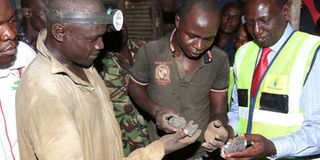Breaking News: At least 10 feared to have drowned in Makueni river
More should and can be done to start taking mining sector seriously

Deputy President William Ruto (right) and gold miners examine a rock containing the precious metal at Osiri Matanda gold mine in Nyatike, Migori. PHOTO | DANIEL ONYANCHA | DPPS
What you need to know:
- Countries such as Ethiopia, Mali, Rwanda, and Zimbabwe rely for foreign currency inflows.
- There is no reason Kenya, despite having a different mineral resource endowment, cannot do the same.
When President Uhuru Kenyatta assented to the 2016 Mining Act, commentators focused on how the new legislation can attract and create a favourable investment regime for incoming and existing large-scale mining investors.
Unfortunately, scant attention was paid to what could possibly be the most significant overhaul in the new legislation: the provision of artisanal and small-scale mining. More should and can be done to start taking this sector seriously as an economic contributor and vehicle for improving livelihoods now that the legislative framework is in place.
The 2016 Mining Act defines artisanal mining as “traditional and customary mining operations using traditional or customary ways and means” and small-scale mining as where, one, the actual or estimated annual extraction of minerals or material bearing minerals does not exceed 25,000 cubic metres, or, two, the prospecting or mining operations do not employ specialised prospecting, mechanised mining technologies, chemicals, including mercury and cyanide, or explosives, or, three, the proposed prospecting or mining operations, do not involve an investment or expenditure that exceeds such amount as may be prescribed by the Cabinet secretary.
Most artisanal and small-scale mining activity in Kenya is either in gemstones or gold. It has been going on for decades albeit shrouded in opacity as the previous Mining Act dating back to 1940 deemed it illegal by criminalising individual possession of minerals. This is despite the fact that Kenya mines and exports gemstones of international repute such as tsavorite and more recently the Baringo ruby, which are mainly mined by individuals or cooperatives.
WESTERN KENYA
Gold mining has also been taking place in western Kenya for decades. This could be an indicator of larger gold deposits if more investment is made in exploration. Recent results announced by Acacia Gold, one of the world’s largest mining companies, lend credence to this theory. The legalisation of artisanal and small-scale mining gives Kenya an opportunity to unlock more revenue from these miners and move beyond simply being a source of raw materials by promoting value-addition through low-cost investment such as cutting and polishing of gemstones, which are currently exported to the Far East in rough and uncut form, often disadvantaging the Kenyan miners.
There needs to be pragmatism about how quickly Kenya can start formalising artisanal and small-scale mining and when it does, it will be important to manage expectations. Not every artisanal miner can become a small-scale miner in the same way that every subsistence farmer cannot become a small-scale commercial farmer.
So, whose responsibility is it to make sure that Kenya does not miss out on this opportunity? The government’s work is clearly cut out for it as such mining was previously an “underground” business. The government needs to put in place fiscal incentives to promote declaration of mineral production by artisanal and small-scale miners and, more importantly, more money in the pockets of miners.
STONE EXPORT
The Ministry of Mining has started construction of gemstone cutting and polishing centres of excellence in Voi to stem the export of rough and uncut stones. More effort must be made to bring reputable private sector partners from countries with an established cutting and polishing industry to train Kenyans and connect the industry of polished stones with international markets.
Not all private companies involved have dubious credentials. The government should make a pro-active effort to engage reputable companies, particularly the Kenyan ones, to understand how the supply chain works.
With accusations that mining uses child labour and is responsible for environmental degradation, enforcement of environmental and labour regulations by the National Environment Management Agency and the Ministry of Mining is vital. This can only be possible if all mines are registered.
International organisations can provide expertise in areas such as environmental compliance and improvement of mining techniques for artisanal and small-scale operators, who often have limited capital to purchase machinery that requires specialist knowledge to operate. Financial organisations experienced in funding small-scale agricultural enterprises can adapt their debt "collaterisation" mechanisms for artisanal miners. However, this can only be done once the sector shows significant signs of growth promise.
Countries such as Ethiopia, Mali, Rwanda, and Zimbabwe rely on this mining sub-sector for foreign currency inflows and there is no reason Kenya, despite having a different mineral resource endowment, cannot do the same.
Rishon Chimboza is head of extractive industries governance for East Africa and southern Africa at Adam Smith International. [email protected]




